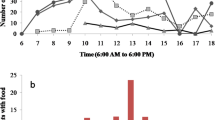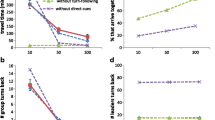Abstract
This work is part of a study on the social organization ofDiacamma rugosum, a large ponerine ant, which lacks a distinctive reproductive queen. This ant forms a small colony and frequently changes its nest site when the environmental conditions become unfavourable. Experiments in the laboratory showed that slight physical disturbances easily caused colony movement. The process of movement consisted of 3 successive phases: a) an exploration period, b) an movement period and c) a final movement period. The movement was organized by leader ants and 5 to 25% of all workers became leaders. These workers showed both tandem running and carrying behaviour during movement, tandem running being employed to recruit workers, whereas carrying behaviour was strictly limited to carrying eggs, larvae, pupae and males. During movement most of the tandem leader ants are those engaged in outdoor works in daily life. Potential of workers to become tandem leaders was correlated with outside works undertaken in daily life.
Similar content being viewed by others
References
Abe, T. & K. Uezu 1977 Biology ofDiacamma rugosum (Le Guillou) in the Ryukyu Islands with special reference to foraging behaviour.Proc. 8th Int. Congr. IUSSI, Wageningen pp. 142–143.
Abraham, M. & J. M. Pasteels 1980 Social behaviour during nest-moving in the antMyrmica rubra L. (Hym. Form.).Insect. Soc. 26:71–78.
Bingham, C. T. 1903 The fauna of British India, including Ceylon and Burma. Hymenoptera 2: Ants and cuckoo-wasps. Taylor & Francis, London, 506pp.
Dobrzański, J. 1966 Contribution to the ethology ofLeptothorax acervorum (Hymenoptera: Formicidae).Acta Biol. Exp. (Warsaw) 26: 71–78.
Fukumoto, Y. 1983 A new method for studying the successive change of colony composition of the ants in the field.Biol. Mag. Okinawa 21: 27–31. (in Japanese with English summary)
Hölldobler B., M. Möglich & U. Maschwitz 1974 Communication by tandem running in the antCamponotus sericeus.J. Comp. Physiol. 90: 105–127.
Hölldobler, B. & J. Traniello 1980 Tandem running pheromone in ponerine ants.Naturwissenschaften 67:360.
Lane, A. 1977 Tandem running inLeptothorax unifasciatus (Formicidae, Myrmicinae): New data concerning recruitment and orientation in this species.Proc. 8th Int. Cong. IUSSI, Wageningen pp. 65–66.
Maschwitz, U., B. Hölldobler & M. Möglich 1974 Tandemlaufen als Rekrutierungsverhalten beiBothroponera tesserinoda Forel (Formicidae: Ponerinae).Z. Tierpsychol. 35:113–123.
Möglich, M., U. Maschwitz & B. Hölldobler 1974 Tandem calling: A new kind of signal in ant communication.Science 186:1046–1047.
Möglich, M. & B. Hölldobler 1974 Social carrying behavior and division of labor during nest moving in ants.Psyche 81:219–236.
Möglich, M. 1978 Social organization of nest emigration inLeptothorax (Hym., Form.).Insect. Soc. 25:205–225.
Möglich, M. 1979 Tandem calling pheromone in the genusLeptothorax: Behavioral analysis of specificity.J. Chem. Ecol. 5:35–51.
Peeters, J. M. 1982 The reproductive strategy of the ponerineOphthalmopone berthoudi: An insight into the evolution of eusociality. In: M. D. Breed, C. D. Michener & H. E. Evans (eds.)The biology of social insects pp. 220–221. Westview Press, Boulder, Colorado.
Uezu, K. 1977 On the foraging activity ofDiacamma rugosum.Biol. Mag. Okinawa 15: 5–17. (in Japanese)
Wilson, E. O. 1959 Communication by tandem running in the ant genusCardiocondyla.Psyche 66:29–34.
Wilson, E. O. 1971 The Insect Societies. Belknap Press of Harvard Univ. Press, Cambridge, 549pp.
Author information
Authors and Affiliations
About this article
Cite this article
Fukumoto, Y., Abe, T. Social organization of colony movement in the tropical ponerine ant,Diacamma rugosum (Le Guillou). J. Ethol. 1, 101–108 (1983). https://doi.org/10.1007/BF02347836
Received:
Accepted:
Issue Date:
DOI: https://doi.org/10.1007/BF02347836




